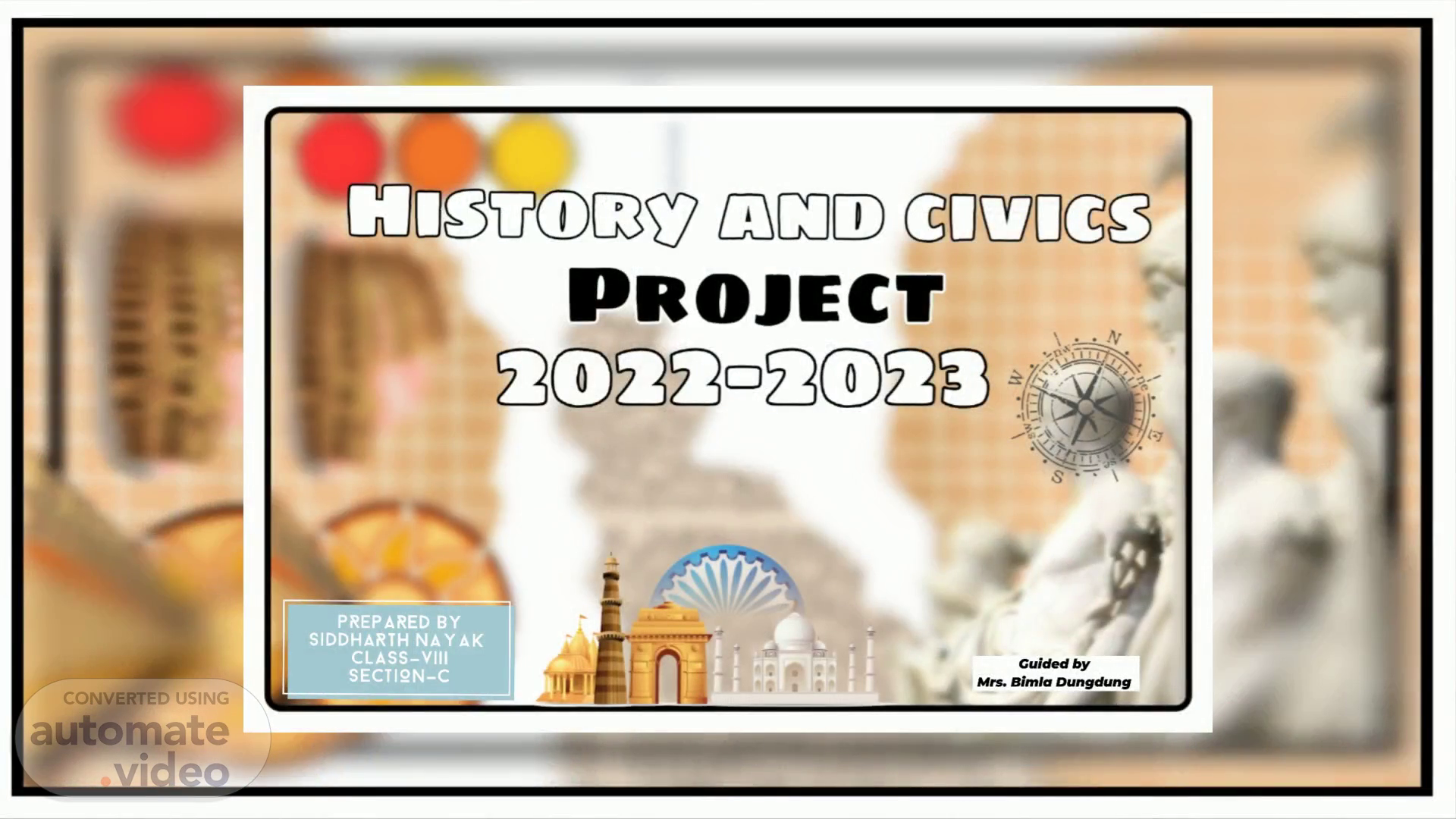
PowerPoint Presentation
Scene 1 (0s)
PROJECT FILE OF HISTORY & CIVICS FOR THE YEAR 2022-23..
Scene 2 (12s)
.. Preface. The Indian independence movement was a series of historic events with the ultimate aim of ending British rule in India. It lasted from 1857 to 1947.The first nationalistic revolutionary movement for Indian independence emerged from Bengal. It later took root in the newly formed Indian National Congress with prominent moderate leaders seeking the right to appear for Indian Civil Service examinations in British India, as well as more economic rights for natives. The first half of the 20th century saw a more radical approach towards self-rule by the Lal Bal Pal triumvirate, Aurobindo Ghosh and V. O. Chidambaram Pillai. Thank you mam, for giving me this opportunity..
Scene 3 (1m 5s)
Content. Content. TOPIC:1. THE INDIAN NATIONAL MOVEMENT. (1) Rise of Indian National Movement. (2) Indian National Movement (1885-1918). (3) The Indian National Movement (1919-1947). (4)The Civil Disobedience Movement..
Scene 4 (1m 25s)
. 1. Rise of Indian National Movement. One of the most distinguishing features of the second half of the 19th century was the birth of nationalism in India. The exploitation of the masses, various rebellions after the revolt of 1857 and the ruthless suppression of revolts awakened the masses. These rebellions reflected the widespread discontent against the British. The need of the hour was an organized all-India movement that could unite the people against British rule..
Scene 5 (1m 48s)
Factors behind the Growth of Nationalism in India.
Scene 6 (2m 23s)
Economic exploitation. Indians realized that the general aim of the British policies in India was to promote their own interest at the cost of the welfare of India. British economic policies turned India into a supplier of raw materials for British factories and a ready market for finished products from England. Millions of craftsmen and artisans were thrown out of employment, resulting in nationwide poverty..
Scene 7 (2m 58s)
Role of the press. The vernacular press played a vital role in spreading modern ideas and creating national awareness. A large number of newspapers were started in the later half of the 19th century. Some of the prominent newspapers were the Amrit Bazar Patrika (Bengali), The Indian Mirror (English), Kesari (Marathi), The Statesman (English) and Rast Goftar (Anglo-Gujrati). These papers criticized the anti-Indian British policies and became a powerful medium to arouse the spirit of nationalism among the people..
Scene 8 (3m 38s)
. Liberty Bill controversy. Courtenay Ilbert, a British lawyer and a legal advisor to the viceroy of India's Council, prepared a bill known as the Ilbert Bill in 1883. The bill proposed that the Indian judges would have the right to try Europeans accused of crimes. It was opposed by British residents in India. The violent reaction of the Europeans and Anglo-Indians to this proposal shocked Indian nationalists. The bill had to be amended in the face of the opposition from the British residents living in India..
Scene 9 (4m 22s)
2. Indian National Movement. (1885-1918). The history of the Indian national movement can be broadly divided into three phases-the moderate phase (1885-1905), the extremist phase (1905-1919) and the Gandhian phase (1918-1947).
Scene 10 (4m 36s)
The Moderate Phase. The leaders who shaped the policy and programmes of the Congress during the first two decades of its existence, between the years 1885 and 1905, were popularly called the moderates. Most of the members of this group came from the upper strata of society consisting of educated professionals like lawyers, barristers, teachers, engineers and writers. These leaders had faith in the British sense of justice and fair play. They believed that the chief obstacle in the way of India's progress was not British rule but the social and economic backwardness of the people..
Scene 11 (5m 16s)
Achievements. The moderates made significant contributions to the Indian national movement. They brought about a national awakening amongst the people and instilled in them a sense of national unity. They trained the people in politics by popularizing the ideas of democracy, civil liberties, secularism and nationalism. They exposed the exploitative nature of British rule in India. This made the people realize the negative impacts of British imperialism..
Scene 12 (5m 54s)
Surat Split. The conflict between the moderates and the radicals surfaced at the Congress Session of 1906. There was a disagreement over the candidature of the next president. But the split was avoided by choosing Dadabhai Naoroji to preside over the session. He was respected by both groups. In this session, Dadabhai declared Swaraj or self-government as the goal of Congress.Surat SplitThe difference between the two sections-the moderates and the radicals continued. It surfaced at the Congress Session in 1907 at Surat. The radicals proposed the name of Lala Lajpat Rai as president of the Surat Session, whereas the moderates proposed the name of Rash Behari Ghosh. This led to chaos and confusion and had to be adjourned to avoid unruly scenes. Thus, the Surat Session ended in a complete rift between the two wings. The moderates met separately and adopted the constitution of the Congress and closed their doors those who did not believe in constitutional methods. The split in the Congress was unfortunate because it gave an opportunity to the British to exploit the situation to their advantage..